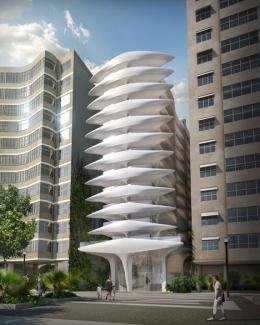
Entry of foreign professionals to Brazil
Long viewed with mistrust by Brazilians, foreign architects are now becoming an increasing presence in Brazil. Most of them are hired by private property developers keen to associate their name with an architect of international renown. There are few international competitions in the country.
Daniel Libeskind has just launched a residential building, Vitra, in São Paulo, with developer JHSF. The partner firm in Brazil is Pablo Slemenson.
Occupying land where the last remaining house stood on Avenida Atlântica, overlooking the sea in the Copacabana district of Rio de Janeiro, an 11-storey hotel is the first project by Zaha Hadid in Brazil, commissioned by businessman Omar Peres. The Brazilian partner firm is Insite Arquitetos.
Another new development in Rio de Janeiro is Leblon Offices, to be home to the Brazilian offices of Vinci Partners, specialised in alternative investments and asset management. Designed by Richard Meier, the building should be finished in 2015. RAF Arquitetura is the Brazilian firm associated with the project.
Diller Scofidio + Renfro was the winner of a design concept competition run in 2009 by the Rio de Janeiro State Department of Culture in partnership with the Roberto Marinho Foundation for a museum in Copacabana, Museu da Imagem e do Som. Brazilian firm Indio da Costa AUDT is providing support for the architectural design and coordinating the complementary projects. The other participants in the competition were Brazilian firms Bernardes Jacobsen, Brasil Arquitetura, Isay Weinfeld and Tacoa Arquitetos, and two foreign firms, Shigeru Ban and Daniel Libeskind.
One of the symbols of the revitalisation of the dock area in Rio de Janeiro is Museu do Amanhã, designed by Spaniard Santiago Calatrava. An integral part of the urban redevelopment project, this public-private partnership is being spearheaded by the Rio de Janeiro city hall and the Roberto Marinho Foundation, with Santander as one of the key financiers. Calatrava’s initial drawings were detailed by Rio-based architecture firm, Ruy Rezende Arquitetura.
Swiss firm Herzog & de Meuron was in charge of designing Arena do Morro in Mãe Luiza a poor area of Natal in the state of Rio Grande do Norte. This multi-sports centre, completed in 2014, is the outcome of work by the Ameropa Foundation, a Swiss institution that supports human development. It provides funding for Centro Pastoral Nossa Senhora da Conceição, a social hub in the Mãe Luiza community. The Ameropa Foundation was responsible for liaising with the Swiss firm, which produced the design free of charge, while Ameropa covered the building costs.
How to work in Brazil
For architects and urbanists to work in Brazil, they must first be registered with Conselho de Arquitetura e Urbanismo (CAU). Resolution 26 of CAU sets forth the rules for architects and urban planners who have trained abroad to register in Brazil – whether they are Brazilian or not. CAU is responsible for ensuring that the training an architect has received abroad is compatible with the degree they would have done in Brazil.
Since CAU was created in 2011, its Education and Training Committee has examined 84 applications by architects trained outside Brazil, 69 of which have been approved. The others are awaiting the presentation of the reports at the plenary session, the final stage of the process.
Foreign firms operating in Brazil must either have a firm registered in the country – and also registered with CAU – or set up a partnership with a Brazilian firm.
Loss of Niemeyer, gain of CAU
Oscar Niemeyer died in December 2014 aged 104. A figurehead and mentor for most architects, he leaves a legacy of great works. But he also leaves behind an approach to architecture that is linked more closely to the figure of the artist-architect than that of the trailblazing architect who designs holistically thinking of structure, form and education. Niemeyer’s passing can be seen as the loss of an idol, but also as permission to move forward along new routes.
In 2011, Brazil’s architects gained their own council after a decades-long battle to have a separate representation from the engineering council. Conselho de Arquitetura e Urbanismo (CAU) now officially represents the profession to the government, providing guidance and oversight for the profession. It is responsible for registering all architects who work in Brazil. Before a professional can work in the country, they must have their registration approved, whether they are from Brazil or not.
Continue reading Mapping Brazil - Architecture: Education


